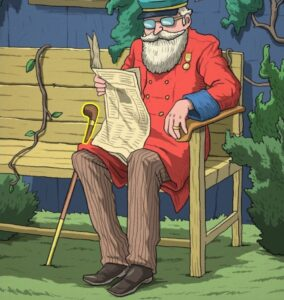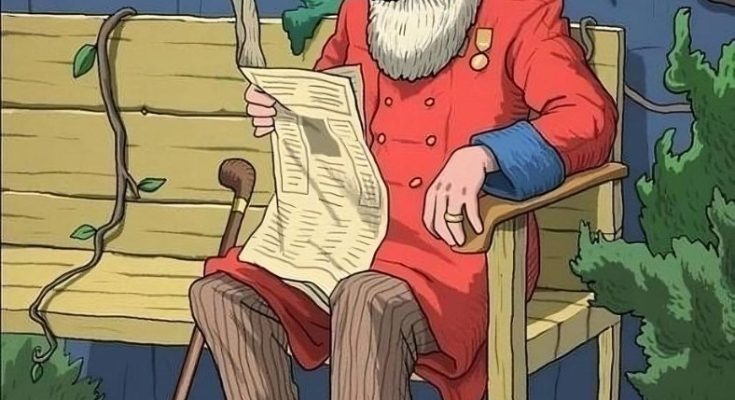Are you ready for a challenge that will put your observation skills to the ultimate test? Here’s a puzzle that’s been stumping even the most eagle-eyed individuals. An elderly gentleman has misplaced his cherished pipe, and it’s your mission to find it. Do you have what it takes to join the elite 2% who can uncover the cleverly hidden object? Let’s dive into the scene and see if you can solve the mystery.
The Puzzle: Where Is the Pipe?
Picture this: An elderly man is seated on a rustic bench outside his cozy, charming home. Dressed in a red, embroidered top and striped brown trousers, he’s entirely engrossed in reading his newspaper. Beside him rests his trusty walking cane, and vibrant green vines climb around the bench, adding a touch of whimsy to the tranquil setting.
The task is deceptively simple—find the missing pipe. But is it really as straightforward as it sounds? Absolutely not. The pipe is cleverly camouflaged, blending seamlessly into the scene. It could be hiding among the vines, concealed in the background, or disguised as part of another object entirely.
Before you read on, take a moment to visualize the scene in your mind. Can you spot the pipe?
Why This Puzzle Is So Tricky
What makes this puzzle so challenging is how it tricks your brain. It relies on subtle misdirection to steer you away from the answer. Here’s why it’s so difficult:
- Clever Disguises: Your brain instinctively searches for objects that look like a traditional pipe in obvious locations—on the ground, among the plants, or on the bench. But this puzzle flips expectations by hiding the pipe in plain sight, disguised as something else.
- Attention to Detail: In a world where distractions are everywhere, puzzles like this force you to focus on the finer details. It’s less about a quick glance and more about truly studying the scene, almost like solving a mystery.
- Breaking Assumptions: Most people struggle to find the pipe because they assume it will look like a classic smoking pipe. This puzzle challenges that assumption and encourages you to think creatively.
Hint: Look at His Belongings
Still can’t find it? Here’s a clue to help you out: The missing pipe isn’t hiding on the ground or among the plants. Instead, it’s cleverly disguised as part of something the gentleman already has with him. Take a closer look at his walking cane. Could it be more than just a cane?
The Solution: Hidden in Plain Sight
If you’ve spent time searching and are ready for the reveal, here it is: The missing pipe is ingeniously integrated into the design of the gentleman’s walking cane. What appears to be the cane’s handle is actually his beloved smoking pipe.
This brilliant disguise is what makes the puzzle so tricky. Your brain naturally looks for separate and distinct objects, not for a dual-purpose design that cleverly combines two items into one.
Why Observation Skills Matter
Puzzles like this are more than just a fun diversion—they’re an excellent way to sharpen your observation and problem-solving skills. Here’s why they’re valuable:
- Improves Focus: In today’s fast-paced world, it’s easy to overlook the small things. Solving puzzles trains your brain to slow down, focus, and pay attention to details.
- Encourages Creative Thinking: The hidden pipe-in-cane design is a perfect example of how thinking outside the box can lead to unexpected solutions.
- Boosts Mental Agility: Engaging in puzzles is like a workout for your brain, enhancing memory, problem-solving abilities, and overall cognitive function.
The Allure of Visual Puzzles
Visual puzzles have captivated people for generations. They tap into our natural curiosity and encourage us to see the world in new ways. But what makes them so universally appealing?
- A Sense of Accomplishment: Solving a tricky puzzle provides a satisfying sense of achievement. It’s like cracking a secret code or uncovering a hidden treasure.
- Timeless Fun: From children to seniors, puzzles appeal to people of all ages, offering a timeless form of entertainment that brings generations together.
- Educational Benefits: Beyond entertainment, puzzles teach patience, perseverance, and the importance of looking at things from different perspectives.
Tips for Solving Puzzles Like a Pro

Want to improve your puzzle-solving skills? Keep these tips in mind:
- Take Your Time: Don’t rush. The best discoveries come when you slow down and carefully examine the details.
- Change Your Perspective: If you’re stuck, try looking at the puzzle from a different angle. A fresh perspective can often reveal the answer.
- Focus on Unlikely Spots: Solutions are often hidden in places you’d never think to look. Pay attention to areas you might usually overlook.
- Practice Regularly: Like any skill, observation improves with practice. The more puzzles you solve, the better you’ll become.
Challenge Your Friends
Do you think you’re part of the elite 2% who can solve this puzzle? Share it with your friends and family to test their observation skills. It’s

